Cravings or Hunger? The Ultimate Guide
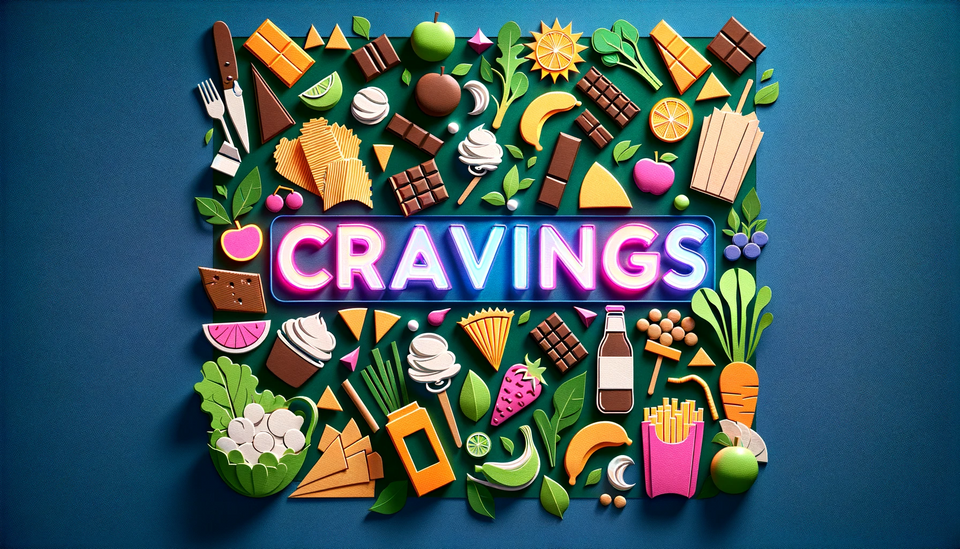
Have you ever found yourself standing in front of the fridge, door ajar, peering inside as if the answers to life’s most profound questions might be written on a block of cheese? You’re not alone.
Food cravings are the body's way of turning our nutritional needs into a game of charades. Sometimes, it feels like we're being held hostage by an insatiable desire for chocolate or the sudden, urgent need for a slice of pizza with extra cheese.
Food cravings are a universal experience, an intricate dance of biology, psychology, and cheese that we've all waltzed with at some point. They're not just a simple yearning for a specific taste; they're a complex phenomenon where our brains play a biochemical game of tug-of-war with our willpower.
Understanding these cravings is more than a matter of curiosity—it's a key to unlocking healthier lifestyle choices and better nutritional habits. It's about deciphering the messages from our body and distinguishing between the song of a doughnut and the genuine need for sustenance.
So, let's embark on a culinary detective adventure, exploring the nooks and crannies of our cravings, and maybe, just maybe, we'll figure out why last night's salad left us dreaming of spaghetti.
Section 1: What Are Food Cravings?
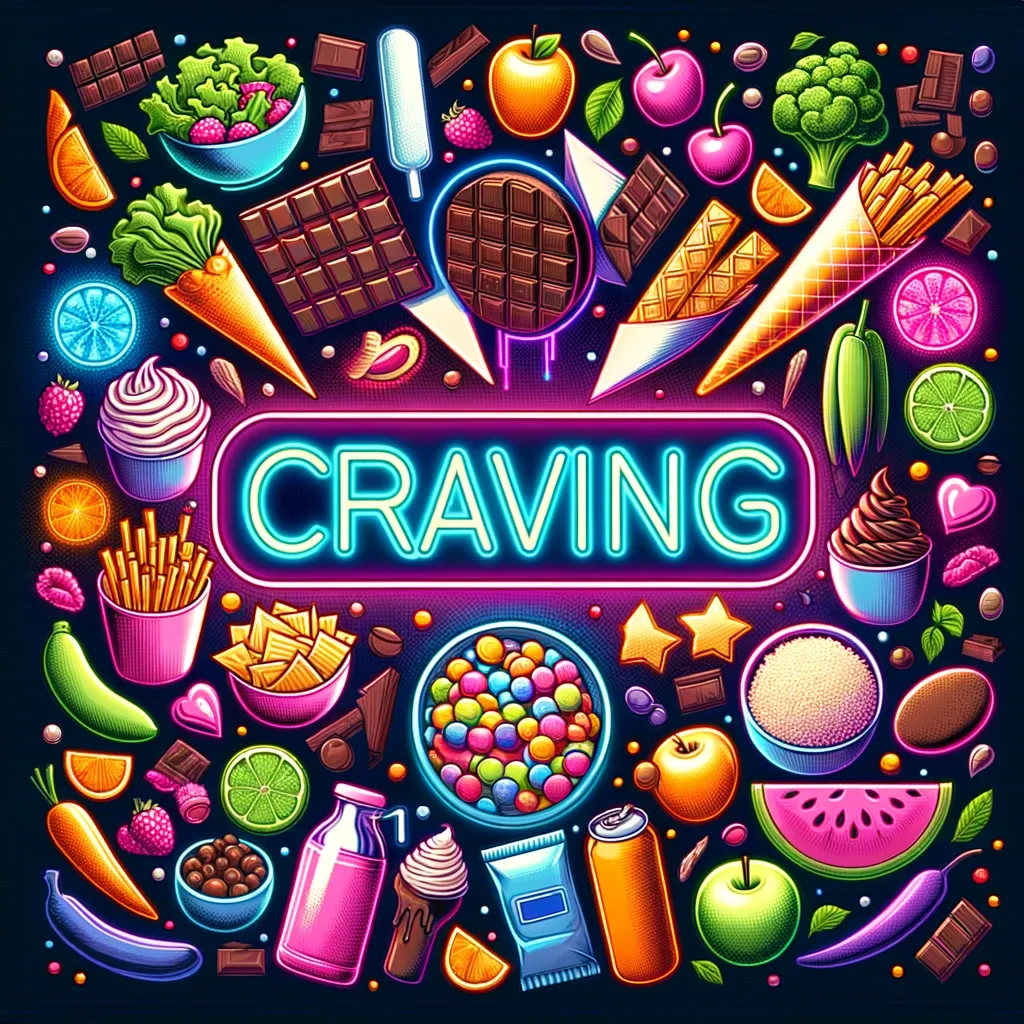
Definition of Food Cravings
A food craving is a powerful and often irresistible desire for a specific type of food. This isn't just a gentle whisper in your mind suggesting you might enjoy a particular snack; it's more like a Broadway marquee flashing in neon lights, urging you to indulge in something specific, often against your better judgment. It's a psychological state that can evoke a physical response, such as salivation or the 'stomach rumble,' compelling you toward culinary satisfaction.
Differentiating Between Hunger and Cravings
Understanding the difference between hunger and cravings is like telling apart twins; they seem similar but have different personalities.
Hunger is the body's signal that it needs fuel; it's a general request for any food. It's patient, can be satisfied with a variety of foods, and usually occurs when you haven't eaten for a while.
Cravings, on the other hand, are the body's demand for a specific taste or texture.
They're insistent, specific, and not always linked to the body's energy needs. You can feel a craving even right after a meal, proving that it's not about filling the tank but about seeking a particular kind of pleasure.
Types of Cravings
Cravings come in many flavors, and they're as diverse as our palates. The most common cravings are for sugar, salt, and fat, each with its own allure.
- Sugar Cravings: These are the sweet siren calls for candy, ice cream, or that extra spoonful of sugar in your coffee. They're often linked to the brain's need for a quick energy boost and the release of feel-good chemicals like serotonin and dopamine.
- Salt Cravings: Reaching for the salty chips or pretzels? Salt cravings can be the body's way of telling you to replenish sodium, an essential mineral that can be depleted through sweat and bodily functions.
- Fat Cravings: Craving for rich, creamy foods? Fat is a dense source of energy and essential to absorb certain vitamins. Plus, it has the magical ability to make many foods taste irresistibly good.
Each type of craving carries its own biochemical background music, playing a tune that our bodies and brains sometimes can't help but dance to. Understanding these cravings is the first step in learning how to harmonize with them without letting them lead us into nutritional discord.
Section 2: The Brain's Role in Cravings
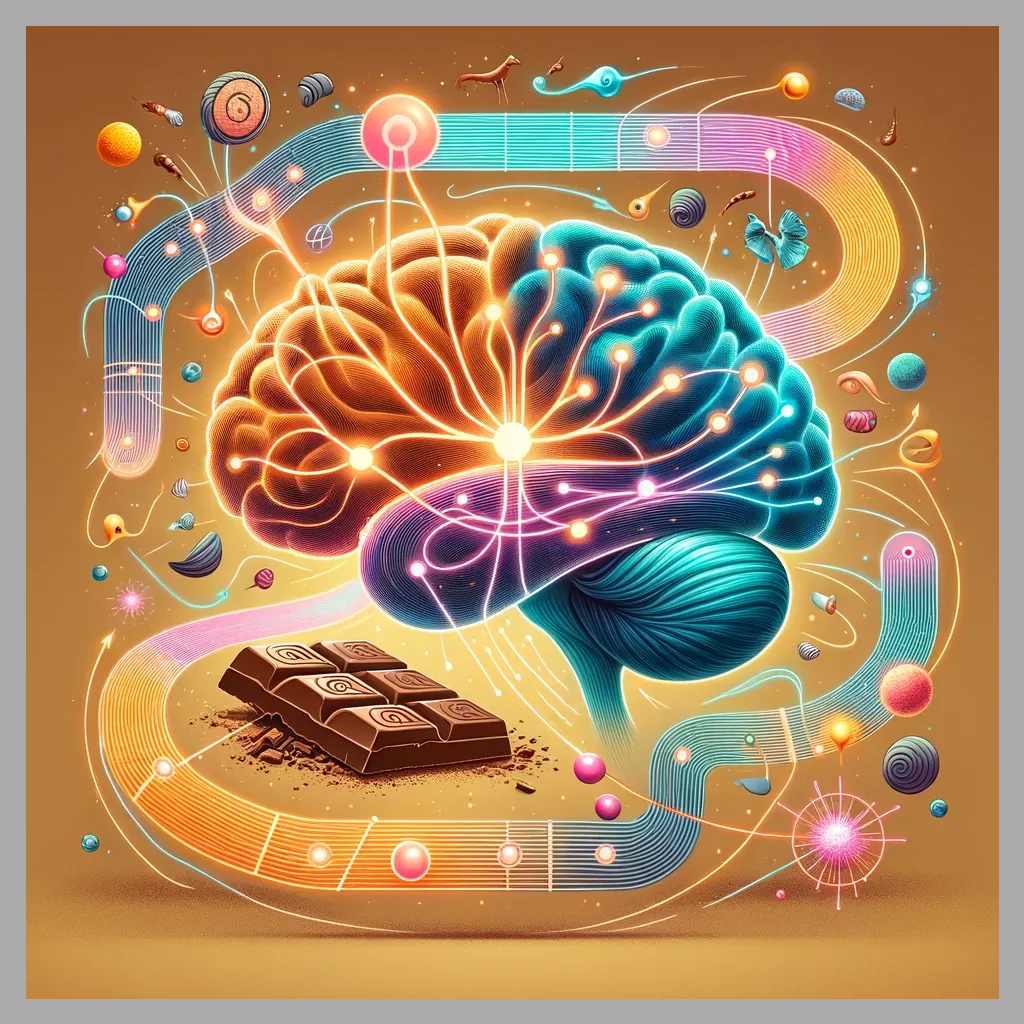
Neurological Perspective on Cravings
To understand cravings from a neurological standpoint, imagine your brain as a bustling city, with neurotransmitters as the commuters, constantly on the move, delivering messages that affect mood, sensation, and thought.
Cravings can be seen as a traffic surge in this city, a rush hour of sorts, where certain neural pathways are flooded with activity. This activity is centered in the brain's reward system, a cluster of structures that govern pleasure and motivation.
How Cravings Are Formed in the Brain
Cravings originate in the brain's limbic system, which is responsible for emotional processing, and the mesolimbic pathway, which is the highway for dopamine signaling. When you experience something enjoyable, like savoring a piece of chocolate, your brain takes note that this action is pleasurable and releases dopamine as a reward.
This release strengthens the neural pathways, creating a memory of pleasure and satisfaction.
The next time you even think about chocolate, your brain anticipates the potential reward and triggers a craving in an attempt to recreate that pleasurable experience.
The Dopamine Connection
Dopamine is often dubbed the "feel-good" neurotransmitter, and it plays a starring role in the story of cravings. It's released in large quantities during pleasurable activities, reinforcing behaviors and creating a feedback loop.
When it comes to food, dopamine not only contributes to the pleasure of eating but also to the anticipation of eating. This anticipation can be so powerful that just seeing or smelling your favorite food can trigger a release of dopamine, kick-starting the craving process even when you're not physically hungry.
The dopamine connection to cravings is a double-edged sword. On one side, it's a natural part of the human experience, driving us toward behaviors that are essential for survival, like eating. On the other, it can lead to the overconsumption of foods that are high in sugar, salt, and fat, which are adept at hijacking this reward pathway.
Understanding the brain's role in cravings is like being handed the map to that bustling city of neurotransmitters. With this map, we can begin to navigate the streets of our cravings more effectively, understanding where they lead and how we can take control of the wheel, steering ourselves towards healthier choices.
Section 3: Emotional Eating and Cravings
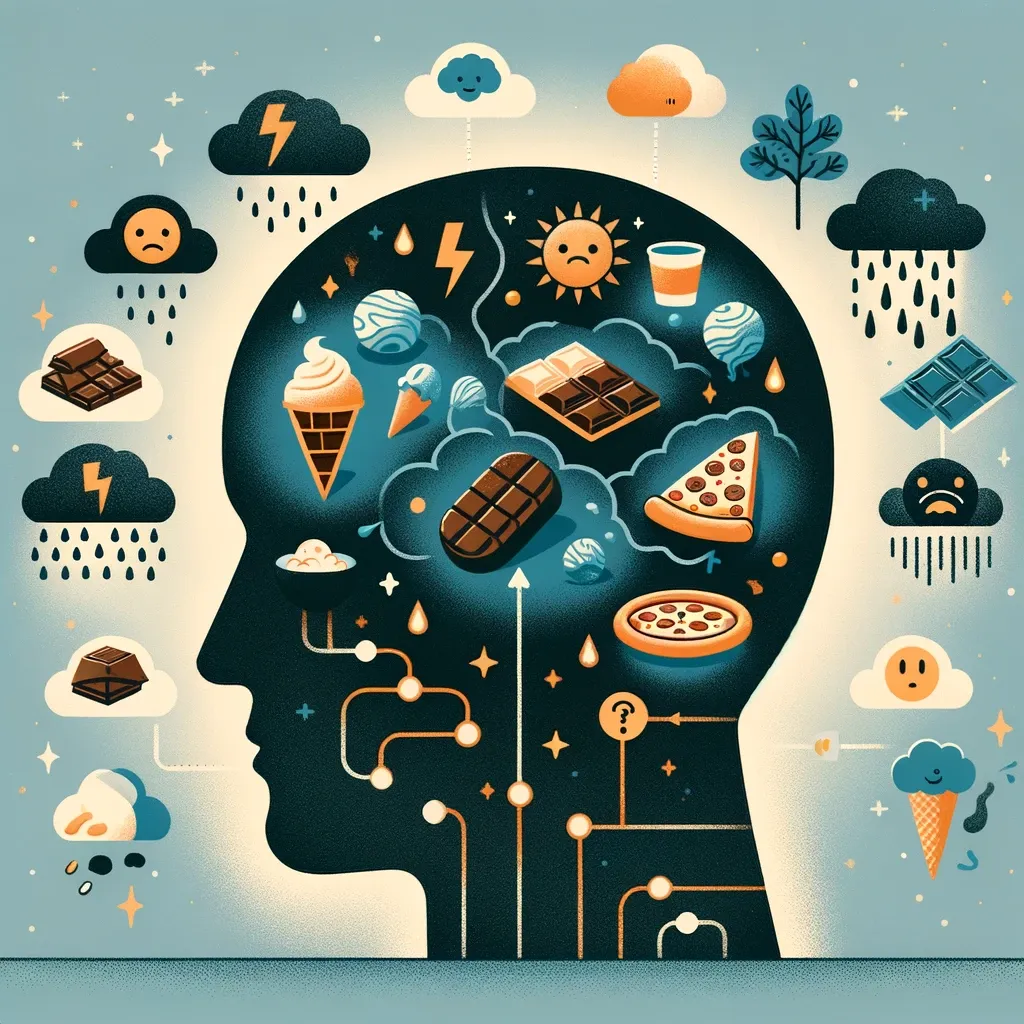
The Link Between Emotions and Food Cravings
Emotions can turn our internal environment into a weather system, with food cravings as the forecast. Just as a storm might trigger a run on the grocery store for essentials, emotional upheavals can send us sprinting toward specific foods.
This connection is rooted in the brain's reward system, which not only responds to pleasurable stimuli but also serves as an emotional coping mechanism. When we're feeling blue, our brains might call for ice cream reinforcements, seeking the dopamine release that comes with that first creamy spoonful.
Comfort Foods: What They Are and Why We Crave Them
Comfort foods are the culinary equivalent of a warm hug from a loved one. They're typically rich, hearty, and tied to sentimental memories or cultural traditions that signal safety and care. These foods are often associated with higher fat, sugar, or salt content, which can stimulate the brain's reward centers.
When we consume foods high in fat, sugar, or salt, our brain's reward system kicks into high gear, releasing a flood of chemicals like dopamine.
This neurotransmitter, often associated with pleasure and reward, gives us a sense of immediate well-being. It's a natural response, harking back to our evolutionary need to prioritize high-energy foods, which were essential for survival.
But in the modern context, these cravings are less about energy and more about emotion.
Comfort foods serve as a coping mechanism, a way to self-soothe during times of emotional turmoil. When we're stressed, the cortisol levels in our body rise, and we instinctively reach for those foods that will give us a quick hit of dopamine and make us feel better, if only temporarily.
When we're lonely or sad, the familiar tastes and smells of our favorite comfort foods can evoke a sense of belonging and warmth, transporting us back to times when we felt secure and happy.
This yearning for comfort foods is a testament to their power to provide a sense of solace and satisfaction that goes beyond the physical. They are a culinary hug that envelops us, reminding us of times when life was simpler, and joy could be found in a steaming bowl of soup or a slice of freshly baked pie.
It's not just about the ingredients or the flavors; it's about the emotional resonance that these foods carry. They are a symbol of comfort, a token of tradition, and a celebration of the simple pleasures that make life sweet.
Stress and Its Impact on Cravings
Stress is like the puppet master of cravings, pulling strings behind the scenes. When we're stressed, our bodies go into a fight-or-flight mode, releasing hormones like cortisol, which can increase appetite and specifically enhance cravings for 'quick-energy' foods.
These are typically high in sugar and fat, which our bodies instinctively reach for as a rapid source of energy to face perceived threats.
Unfortunately, our modern-day stressors are rarely solved by a sugar rush, leading to a cycle of stress eating that can be hard to break.
The interplay between stress and cravings is a delicate dance. While we may not be able to eliminate stress from our lives, understanding its influence on our eating habits can empower us to make more mindful choices.
By recognizing the emotional roots of our cravings, we can start to address the underlying feelings instead of just the food symptoms, leading to healthier coping strategies and a more balanced relationship with food.
Section 4: Environmental and Social Influences

How Advertising and Social Media Trigger Cravings
In today's digital age, we're bombarded with images and videos of food that look nothing short of divine. Advertising and social media have become the modern-day sirens of the culinary world, luring us with glossy images of dripping chocolate and cheese pulls that could stretch for meters.
These visuals are designed to ignite our senses, often leading to instant cravings. The science behind this is simple: when we see delicious food, our brain's reward system lights up, and the desire to experience that anticipated pleasure is kindled. Social media platforms, with their endless streams of food content, have become feasting grounds for our eyes, and by extension, our stomachs.
The Role of Culture and Family in Shaping Our Cravings
Our cravings are not just a matter of personal taste but are also deeply rooted in our cultural and familial backgrounds. From the spices used in Indian cuisine to the savory flavors of
Mediterranean etc dishes, cultural heritage informs our palate preferences from a young age. Family traditions, such as grandma's famous apple pie or a parent's special braai sauce, can create a nostalgic yearning for these familiar flavors. These cultural and familial ties to food are strong, often transcending mere hunger and becoming emblematic of identity and belonging.
Peer Influence on Eating Behavior
Let's not underestimate the power of peer pressure at the dinner table. Eating is a communal activity, and the preferences and habits of our friends can subtly influence our own food choices.
If your brunch group leans towards avocado toast and smoothie bowls, you might find yourself craving these foods more often. Conversely, a circle that indulges in fast food can sway your cravings in that direction. It's not just about fitting in; it's about the shared experience. The foods our peers enjoy can become the foods we crave, simply because they're part of the social fabric of our dining experiences.
In essence, our environment and social circles serve as the stage and actors in the play of our cravings.
They can set the scene for healthy choices or lead us down a path of less nutritious indulgences. Recognizing the external cues that trigger our cravings can help us make more conscious decisions, ensuring that our food choices align with our personal health goals and not just the latest trend on our feeds.
Section 5: The Impact of Diet and Nutrition
The Role of Deficiencies and Diet Quality in Cravings
Cravings can sometimes be the body's cryptic way of signaling nutritional deficiencies. When we're low on a particular nutrient, our body sends out an SOS in the form of food cravings.
Let's decode some common cravings and what they might be telling us about our nutritional status:
Chocolate Cravings:
Often, when we're craving chocolate, it's not just for the taste but for what it contains. Chocolate is a notable source of magnesium, a mineral involved in over 300 biochemical reactions in the body, including muscle and nerve function, blood glucose control, and blood pressure regulation. If you're constantly dreaming of chocolate bars, it might be worth considering whether you're getting enough magnesium from other sources like nuts, seeds, whole grains, and leafy green vegetables.
Red Meat Cravings:
Craving a juicy steak or a hearty hamburger? It might be your body's way of hinting at an iron deficiency. Iron is crucial for producing hemoglobin, which carries oxygen in the blood. A lack of iron can lead to anemia, characterized by fatigue and weakness. Other iron-rich foods include beans, lentils, tofu, and fortified cereals, which can also help satisfy these cravings while addressing the underlying nutritional need.
Salty Snacks Cravings:
If you find yourself reaching for salty snacks, it could be a signal of a sodium deficiency or dehydration. Sodium plays a vital role in fluid balance, nerve transmission, and muscle function. However, it's rare to be deficient in sodium since it's abundant in many foods. More often, this craving could be a sign that you need to hydrate more or that you're experiencing stress, as cortisol can influence cravings for salty foods.
Sweets Cravings:
A desire for sweets can be one of the most common cravings, especially when we're feeling low energy. It's the body's quick-fix request for a rapid increase in blood sugar. However, regularly consuming sweets can lead to a cycle of highs and lows in blood sugar levels, which can perpetuate cravings. To combat this, focus on complex carbohydrates like whole grains, which provide a slower and more sustained release of energy.
Cheese Cravings:
Cheese is rich in calcium and fatty acids, and craving it might indicate a need for more of these nutrients. Calcium is essential for bone health, and fatty acids are important for brain function and cell growth. If you're vegan or lactose intolerant and find yourself craving cheese, look to plant-based sources of these nutrients, such as leafy greens for calcium and flaxseeds or walnuts for fatty acids.
Ice Cream Cravings:
Craving ice cream doesn't just mean you're in the mood for a treat; it could also be a sign that you're seeking comfort or a serotonin boost, as dairy contains tryptophan, which the body uses to make serotonin. This is especially true if you find yourself craving ice cream more often during periods of stress or sadness.
Understanding these signals is not about self-diagnosis but about starting a conversation with your body. It's about recognizing patterns and responding with curiosity rather than judgment.
If you're frequently experiencing specific cravings, it's a good idea to evaluate your diet as a whole to ensure it's balanced and to consult with a healthcare provider if you suspect a deficiency. By doing so, you can tailor your nutrition to better meet your body's needs, potentially reducing cravings and improving your overall health.
How Processed Foods Are Engineered to Be Irresistible
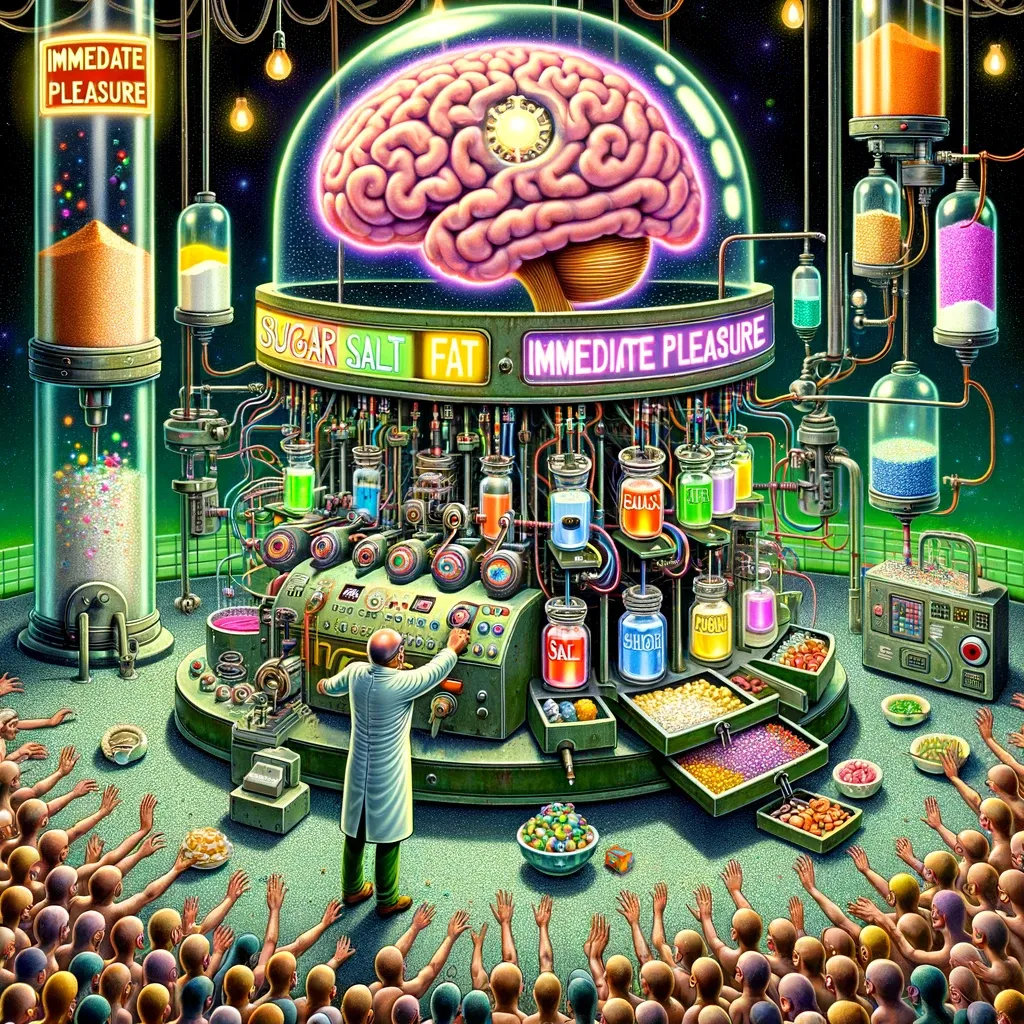
Processed foods are often the culprits behind our most insistent cravings. They're the result of meticulous engineering, designed to hit the 'bliss point'—a perfect storm of sugar, salt, and fat that lights up our brain's reward system like a Christmas tree.
These foods are crafted to provide an immediate pleasure response, encouraging repeat consumption. The combination of flavors and textures in processed foods is no accident; it's a science, one that taps into our primal instincts to seek out calorie-dense foods, making these modern concoctions something our ancestors could never have imagined, and our modern selves can hardly resist.
Let's break down the elements that make processed foods so tempting:
1. The Bliss Point:
The 'bliss point' is a term used in the food industry to describe the optimal level of sweetness, saltiness, or richness that makes food most enjoyable.
Food scientists use precise combinations of sugar, salt, and fat to hit this sweet spot, ensuring that each bite delivers maximum pleasure.
This isn't just guesswork; it's a calculated process, often involving extensive consumer testing and sophisticated algorithms to determine the most addictive blend of flavors.
2. Sugar and the Brain:
Sugar plays a pivotal role in the allure of processed foods. When we consume sugar, it triggers the release of dopamine, a neurotransmitter associated with pleasure and reward. This response is similar to what occurs with certain drugs, reinforcing the desire to experience that pleasure again. The brain remembers the foods that cause this reaction and creates cravings for them as a result.
3. Fat: The Mouthfeel Factor:
Fat is another key player in the appeal of processed foods. It contributes to the texture and mouthfeel, making foods creamy, flaky, or crispy. But beyond texture, fats also interact with specific receptors in our mouths and digestive systems, signaling the brain to release pleasure-related neurotransmitters. This response not only makes the food more satisfying but also can create a powerful urge to eat more.
4. Salt and Flavor Enhancement:
Salt is not just a preservative; it's also a flavor enhancer. It can bring out the best in other flavors, making them more pronounced and enjoyable. Moreover, salt consumption triggers the release of opioids in the brain, compounds that can produce feelings of euphoria and further enhance the addictive nature of salty foods.
5. The Role of Texture:
Crunchy, creamy, or crispy – the texture of food can be just as addictive as its taste. Food manufacturers spend a great deal of time perfecting the 'mouthfeel' of foods to make them more appealing. The contrast in textures can also play a role; for example, the crunch of a cookie followed by a smooth, creamy filling can create a sensory experience that's hard to resist.
6. The Impact of Aromas:
Aroma compounds are engineered to mimic the smells of fresh, wholesome foods, triggering memories and emotions associated with eating. These scents can stimulate appetite and cravings even before the food is tasted.
7. The Psychology of Color:
The color of food can greatly affect our perception of its taste and quality. Food companies use colors to make their products more attractive and to signal certain flavors that align with consumer expectations.
8. The Vanishing Caloric Density:
Some processed foods are designed to dissolve quickly in the mouth, a phenomenon known as 'vanishing caloric density.' This tricks the brain into thinking that fewer calories are being consumed, reducing the body's natural tendency to feel full and promoting overeating.
9. The Reward Cycle:
The combination of these elements creates a powerful reward cycle. The brain remembers the pleasure of eating these foods and creates a desire to experience it again, leading to cravings and often, habitual consumption.
Understanding the science of processed foods can empower consumers to make more informed choices.
While these foods can be enjoyed in moderation, being aware of their engineered nature can help us recognize cravings and make decisions that align with our health and well-being.
It's not about demonizing processed foods but about understanding their place in our diet and taking control of our eating habits.
The Gut-Brain Axis and Its Role in Cravings
The gut-brain axis is the biochemical signaling that takes place between the gastrointestinal tract and the central nervous system. This communication superhighway is constantly sending messages back and forth, and it turns out that our gut microbes have a say in the conversation. These tiny organisms play a role in managing our cravings by influencing the production of neurotransmitters like serotonin, a significant portion of which is produced in the gut.
A diverse and balanced gut microbiome can mean more balanced moods and cravings, while an imbalanced one can lead to more erratic eating behaviors. It's a fascinating reminder that what we eat doesn't just affect our waistlines but also our well-being, right down to the microscopic level.
In summary, diet and nutrition are not just about fueling our bodies; they're about informing our choices and shaping our desires. By understanding the nutritional underpinnings of our cravings and the impact of the foods we eat, we can begin to navigate our cravings with more insight and intention, leading to a healthier and more harmonious relationship with food.
Section 6: Psychological Strategies to Manage Cravings

Mindful Eating Practices
Mindful eating is about engaging all the senses to experience food more intensely — without judgment. It's a practice of being fully present during meals, paying attention to the taste, texture, and aroma of your food, as well as your body's hunger and fullness cues.
By eating mindfully, you can recognize when a craving is not due to hunger but rather emotional needs or external cues. This awareness allows you to pause and choose how to respond to the craving instead of being swept away by it.
Simple practices like eating without distractions, chewing slowly, and savoring each bite can help make food more satisfying, which may reduce the intensity and frequency of cravings.
Cognitive-Behavioral Techniques
Cognitive-behavioral therapy (CBT) techniques can be effective in managing cravings by changing the thought patterns that lead to them. One strategy is to identify the triggers that lead to cravings and develop a plan to deal with them.
For example, if boredom triggers a craving for chips, you might plan to take a walk or call a friend when boredom strikes.
Another technique is to challenge and reframe irrational thoughts that fuel cravings, such as "I must have chocolate to get through this stressful day." By questioning the validity of these thoughts and replacing them with more rational ones, you can reduce the power of cravings.
Replacing Cravings with Healthier Habits
Creating new, healthier habits to replace the old ones associated with cravings is a long-term strategy that can lead to sustainable change. This could involve stocking up on healthy snacks that are satisfying and enjoyable, so when a craving hits, you have better options at hand.
It can also mean developing non-food related coping mechanisms for emotional distress, like engaging in physical activity, practicing deep-breathing exercises, or pursuing a hobby. Over time, these healthier habits can become your new go-to response to cravings, effectively rewiring your brain's reward system to find pleasure in activities that support your well-being.
By employing these psychological strategies, you can gain greater control over your cravings.
It's not about denying yourself pleasure, but rather about finding balance and making choices that contribute to your overall happiness and health. With practice, managing cravings can become a natural part of your lifestyle, leading to a more empowered and mindful approach to eating.
Strategic Delaying Tactics
Delaying tactics are a psychological maneuver to manage cravings by postponing the act of giving in to them.
The strategy is based on the understanding that cravings often pass with time. When a craving hits, set a timer for 10 minutes and engage in a different activity. During this period, the intensity of the craving may decrease significantly, making it easier to make a rational decision about whether to indulge or not.
This brief pause can provide a moment of clarity, allowing you to consider the consequences of giving in to the craving and to choose a healthier option if appropriate.
Section 7: Nutritional Approaches to Curb Cravings
Balancing Macronutrients to Prevent Cravings
A balanced diet is like a well-tuned orchestra; each macronutrient plays a vital role in creating a harmonious meal. Carbohydrates, proteins, and fats all have their unique functions and digest at different rates, providing a steady release of energy. By including a mix of these macronutrients in your meals, you can stabilize blood sugar levels and prevent the rapid spikes and dips that often lead to cravings.
For instance, pairing complex carbs with lean protein and healthy fats can keep you feeling fuller for longer and help ward off the urge to indulge in less nutritious snacks.
The Importance of Fiber and Whole Foods
Fiber is the unsung hero of the digestive process, adding bulk to your diet and slowing down the absorption of sugar into your bloodstream.
This slow release helps maintain steady blood sugar levels, which can reduce the likelihood of experiencing cravings. Whole foods, such as fruits, vegetables, whole grains, nuts, and seeds, are naturally high in fiber and packed with essential nutrients.
They provide a sense of satiety and nourishment that highly processed foods lack. By focusing your diet on whole foods, you can help curb cravings and provide your body with the nutrients it needs to function optimally.
Here are five sources of high-fiber, nutrient-rich whole foods and tips on how to seamlessly integrate them into your daily meals:
- Legumes (Beans, Lentils, Chickpeas)
- Tip: Start by adding legumes to salads, soups, or as a base for homemade veggie burgers. They're also great for making heartier versions of dips like hummus.
- Whole Grains (Quinoa, Brown Rice, Oats)
- Tip: Swap out white rice and pasta for their whole-grain counterparts. Start your day with a bowl of oatmeal topped with fruit and nuts for an extra fiber boost.
- Nuts and Seeds (Chia Seeds, Flaxseeds, Almonds)
- Tip: Sprinkle a handful of nuts or seeds over your yogurt, salad, or blend them into smoothies. Chia and flaxseeds can also be used as egg substitutes in baking, adding fiber to your treats.
- Fruits and Vegetables (Berries, Leafy Greens, Apples)
- Tip: Aim to fill half your plate with vegetables at each meal. Snack on whole fruits like apples and berries, which are high in fiber and can satisfy a sweet craving.
- Whole Grain Breads and Pastas
- Tip: Choose breads with whole grains and seeds. When it comes to pasta, look for 100% whole grain options or try pasta made from legumes for an extra protein and fiber content.
By focusing on these whole food sources, you're not only adding fiber to your diet but also a wide array of vitamins, minerals, and antioxidants that contribute to your overall health.
Remember, the key to dietary changes is to start small and be consistent. Gradually increasing your intake of these foods can help your digestive system adjust and make these healthy habits a permanent part of your lifestyle.
Hydration and Its Role in Managing Cravings
Sometimes, what we perceive as a food craving is actually thirst in disguise. Hydration is crucial for maintaining bodily functions, and even mild dehydration can masquerade as hunger, leading us to reach for a snack when a glass of water is what our body truly needs.
Drinking adequate fluids throughout the day can help prevent this confusion and may reduce cravings. Additionally, sometimes drinking water before meals can contribute to a feeling of fullness, potentially leading to less food intake and a decrease in the likelihood of craving extra servings or dessert.
Incorporating these nutritional strategies into your daily routine can help manage and minimize cravings. It's not about strict dieting or denying yourself the joy of eating; it's about creating a balanced and nourishing environment in your body that naturally diminishes the urge to indulge in less healthy options.
By doing so, you can support your body's natural hunger cues and enjoy a more satisfying and healthful relationship with food.
Section 8: When Cravings Point to Deeper Issues

Understanding When Food Cravings Are a Sign of Eating Disorders
Cravings are a normal part of the human experience, but when they become persistent, extreme, and coupled with feelings of guilt or a loss of control, they may be indicative of an underlying eating disorder.
Conditions such as binge eating disorder, bulimia, and anorexia can all have cravings as a component, often as a prelude to disordered eating behaviors.
For instance, an intense and uncontrollable craving for large amounts of food may lead to binge eating episodes, while cravings followed by extreme guilt may prompt compensatory behaviors seen in bulimia.
Recognizing these patterns is crucial, as they are signs that cravings are not merely cravings anymore but symptoms of a more serious issue.
The Link Between Cravings and Mental Health Disorders
Cravings can also be intertwined with mental health disorders such as depression and anxiety. For some, food becomes a source of comfort during periods of low mood or a coping mechanism to deal with anxiety, leading to specific cravings.
These cravings are often for foods that trigger a temporary mood boost, creating a cycle where the craving is a symptom and a temporary 'solution' to emotional distress.
It's important to discern whether food cravings are simply a matter of wanting a particular food or if they are a form of self-medication for emotional pain.
When to Seek Professional Help
If cravings are causing significant distress, are associated with unhealthy eating behaviors, or are impacting your physical or emotional well-being, it's time to seek professional help. This is particularly important if you find that your cravings lead to eating much more than you intended, eating in secret, or feeling out of control around food.
Health professionals, including dietitians, psychologists, and psychiatrists, can help address both the physiological and psychological aspects of cravings. They can assist in developing healthier eating patterns, addressing any nutritional deficiencies, and providing strategies to cope with emotional triggers for cravings.
It's essential to remember that seeking help is a sign of strength, not weakness.
By acknowledging when cravings are more than just a passing desire for a specific food, you can take the first step towards understanding and managing them in a way that supports your overall health and well-being. Professional guidance can provide the tools and support needed to navigate the complex interplay between food, cravings, and emotional health.
Conclusion
Throughout our exploration of the labyrinthine world of food cravings, we've uncovered that these urges are far more than simple whims. They are woven from the threads of our neurological framework, emotional landscape, and the environmental cues that surround us. We've seen how the brain's intricate reward system, our emotional state, and even the gut-brain axis play pivotal roles in the cravings we experience.
As we close this chapter, I encourage you to reflect on your personal craving triggers. Are they born of habit, emotion, or perhaps a nutritional need?
Understanding the root of your cravings is like holding a compass in the journey of self-awareness; it can guide you towards making choices that align with your body's needs and your personal well-being.
Embracing a balanced relationship with food is not about strict diets or willpower battles against cravings; it's about tuning in to your body's signals, nourishing it with what it truly needs, and finding joy and satisfaction in the meals you eat. It's about recognizing that food is not just fuel but also comfort, celebration, and a source of pleasure.
Remember, occasional indulgences are part of a healthy life, and cravings don't have to be your adversary.
With the insights and strategies we've discussed, you're now better equipped to understand and manage your cravings, not as a commander in a battle, but as a knowledgeable friend to your body and mind.
Here's to thriving in a life where food is a friend, and cravings are but a conversation with your inner self, guiding you to your best and healthiest life.
Call to Action
To help you on this journey, I've created a handy Cravings Journal template. It's a tool designed to help you track your cravings, understand their patterns, and discover what might be triggering them. Download the Cravings Journal template here and start your path to mastering your cravings.
And if you find that your cravings are more complex, or you're seeking a more personalized approach, don't hesitate to reach out.
Schedule a consultation with me, and together, we can craft a strategy that's as unique as your cravings, tailored to fit your lifestyle and nutritional needs. Let's work together to create a plan that not only satisfies your taste buds but also supports your health and well-being. Book your personal consultation today.
Your journey towards a balanced relationship with food and a thriving life is just a click away. Let's embark on this delicious adventure together.